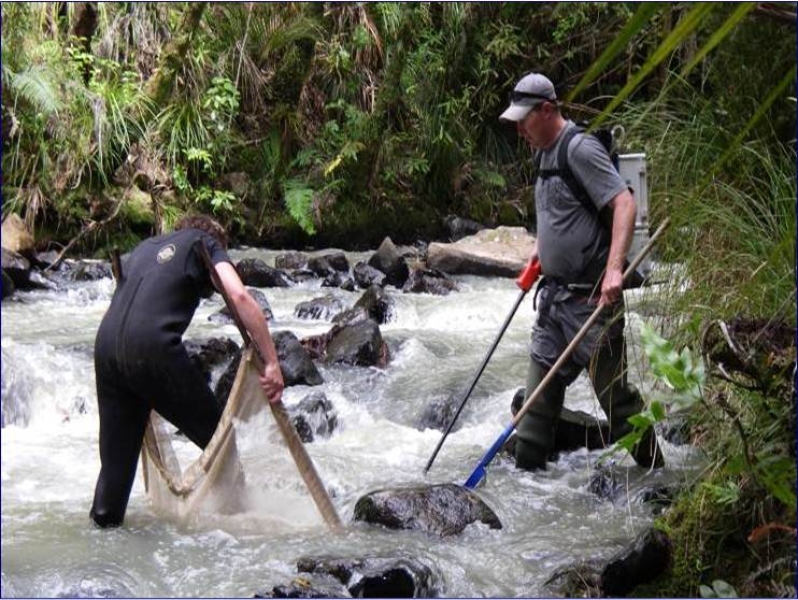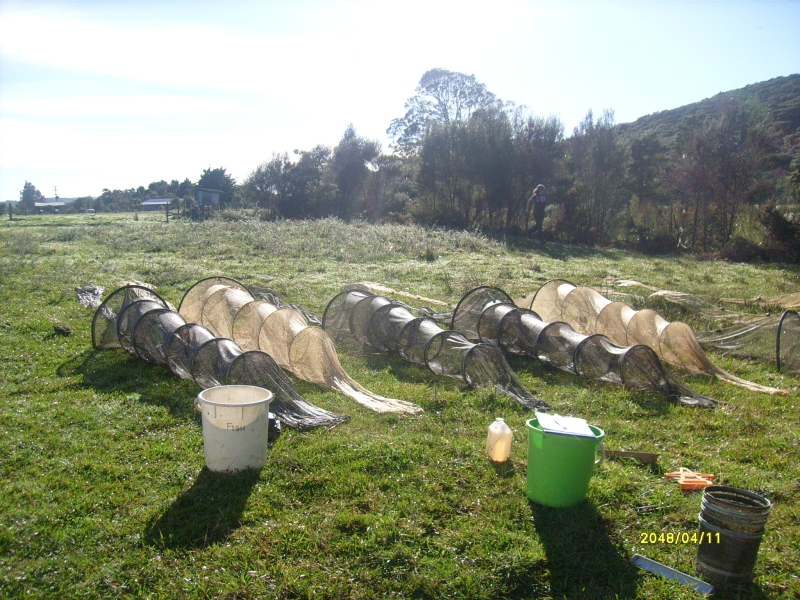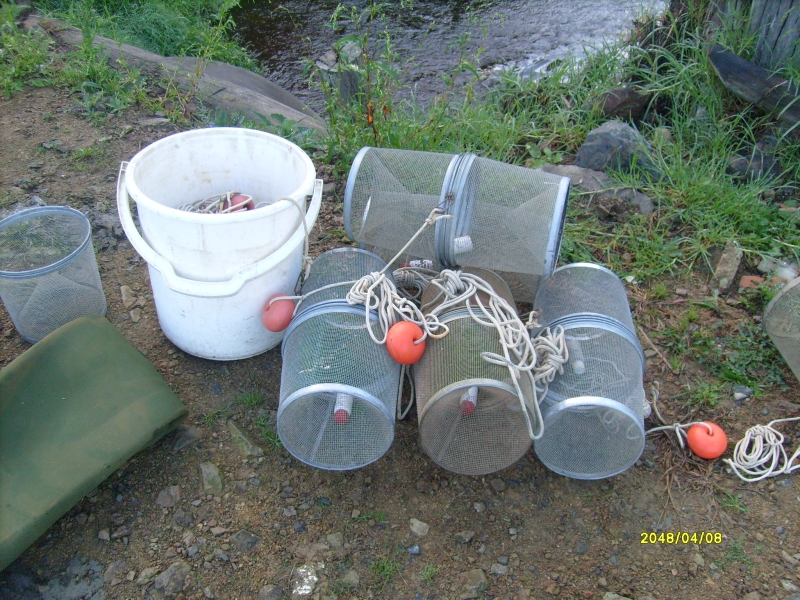There are a range of different sampling methods which can be used, including electric fishing, fyke nets, Gee-Minnow traps, scoop nets, whitebait nets and observation.
The status of an eel population can be described by age or length frequency information, and catch rates if consistent capture techniques are employed over time. However, it is difficult to find fishing methods which sample both large and small eels with equal effectiveness, so that you are able to make comparisons about the long term abundance of eels in a particular catchment with confidence.
Keep in mind that variable capture rates can occur as not all eels forage at the same time, and environmental conditions may also influence capture rates. By sampling during a short period and during settled weather, the influence of environmental conditions upon capture rates can be minimised.
The range of sampling methodologies used in tuna surveys will be dependent on the habitat types to be sampled and the accessibility of these methods to people undertaking the research. A wide variety of techniques, each with their own strengths and limitations, are used to sample or observe fish populations depending on the species of interest. These include:
Electric fishing (back pack or boat)
Electric fishing is a method which uses electricity to temporarily stun fish, so that they rise to the surface for removal by the researcher. The fish are then placed in a bucket of freshwater, where they can be anaesthetised, identified and measured, revived, and returned to the waterway when finished.
This method is typically restricted to use in non-saline, relatively shallow waters. Electric fishing is effective in streams and along shallow shorelines but not in deep lakes and rivers.
There are a number of types of electric fishing machines currently in use in New Zealand, including:
- battery- or generator-powered backpacks - the EFM300 model is made in New Zealand
- electric fishing boats. These can be assembled from imported and/or local products. One unit, owned by the University of Waikato, is available for hire
- shore-based, mains electric fishing sets.
More information about the EFM300
A combination of single-pass (once over) and multiple-pass (exhaustive, quantitative) electric fishing sampling can be used. Electric fishing may underestimate the occurrence of some species, which may be startled and swim out of the range of the electric fishing machine (e.g. smelt).
Nets and traps
A large variety of nets and traps are available to capture fish.
Fyke nets
Fyke nets are recognised to be size selective and therefore this technique is only suitable for collecting data from eels of a size that can be retained within the net.
Small eels escape through the mesh of standard commercial fyke nets (12 mm) and may avoid nets in which large eels are already present. Even fine-meshed fykes (4 mm) do not capture small eel size classes in expected proportions. Large fish can feed on other fish that are captured (be aware of this when doing feeding or diet studies) or prevent smaller fish from entering the net. Baited nets tend to be more effective than un-baited nets as they will attract fish from a wider area, especially in flowing water.
Typically, a series of nets or traps (e.g. 10–20, set at either a pre-determined distance apart and/or in a variety of representative habitats) are used to sample stretches of the main stem rivers and streams (where water is deep enough). Netting should be concentrated over as few nights as possible to diminish the likelihood of environmental parameters affecting catches unduly.
One way of estimating the eel population of an area is by using a depletion fyke netting method. In this method, fyke nets are set to fish overnight in a particular area for a period of three nights, although the nets are emptied each day and the catch is retained in a keep bag, to permit the numbers/species of eels to be recorded. Once the day's information has been logged, the eels are released at a location at least 5 km upstream of the nets to ensure that the same eels are not recaptured in the nets on subsequent nights. Over the course of the netting period, the population of eels in the area is expected to decrease, as eels are captured. The input of survey data to a population estimator can then be used to provide an estimate of the capture efficiency and hence population size.
Mark and recapture methods are also used around the world to estimate fish populations.
Gee-minnow traps, scoop and whitebait nets
Gee-minnow traps, hand-held scoop nets, whitebait nets, and seine and gill nets are also methods that can be used to sample freshwater fish, depending on the habitat and species of interest. Hand-held scoop nets and whitebait nets can be used to sample glass eels entering freshwater from the sea between August and December.
Observations
Night time observations of fish can be made using spot lighting equipment, where the water is clear and shallow enough to see clearly. Although this is relatively cheap and easy to undertake, there are a number of drawbacks to this technique. For example, if you wanted to quantitatively characterise the tuna population, sometimes it is difficult to see clearly, difficult to identify shortfin from longfin tuna, and some tuna may be covered by in stream debris or living under the banks.
References and further reading
Berg, R. (1990). The assessment of size-class proportions and fisheries mortality of eel using various catching equipment. Internationale Revue der gestamten Hydrobiologie 75: 775-780. http://onlinelibrary.wiley.com/doi/10.1002/iroh.19900750611/abstract
Carle, F.L., Strub, M.R. (1978). A new method for estimating population size from removal data. Biometrics 34: 621-630.
Chisnall, B.L., West, D.W. (1996). Design and trials of a fine meshed fyke net for eel capture, and factors affecting size distribution of catches. New Zealand Journal of Marine and Freshwater Research 30: 355-364. http://www.tandfonline.com/doi/abs/10.1080/00288330.1996.9516722
Jellyman, D.J. (1991). Factors affecting the activity of two species of eel (Anguilla spp.) in a small New Zealand lake. Journal of Fish Biology 39: 7-14. http://onlinelibrary.wiley.com/doi/10.1111/j.1095-8649.1991.tb04336.x/abstract
Jellyman, D.J. (1989). Diet of two species of freshwater eel (Anguilla spp.) in Lake Pounui, New Zealand. New Zealand Journal of Marine and Freshwater Research 23: 1-10. http://www.tandfonline.com/doi/abs/10.1080/00288330.1989.9516334
Jellyman, D.J., Chisnall, B.L. (1999). Habitat preferences of shortfinned eels (Anguilla australis), in two New Zealand lowland lakes. New Zealand Journal of Marine and Freshwater Research 33: 233-248. http://www.tandfonline.com/doi/abs/10.1080/00288330.1999.9516873
Jellyman, D.J., Graynoth, E. (2005). The use of fyke nets as a quantitative capture technique for freshwater eels (Anguilla spp.) in rivers. Fisheries Management and Ecology 12: 237-247. http://onlinelibrary.wiley.com/doi/10.1111/j.1365-2400.2005.00445.x/abstract
Matheson, F., Dugdale, T., Wells, R., Taumoepeau, A., Smith, J. (2004). A new method to sterilise freshwater fishing nets. Water and Atmosphere 12(3): 17. http://www.niwa.co.nz/sites/default/files/import/attachments/net.pdf
Matheson, F., Dugdale, T., Wells, R., Taumoepeau, A., Smith, J. (2007). Efficacy of saltwater solutions to kill introduced freshwater species and sterilise freshwater fishing nets DoC Research & Development Series 261. http://www.doc.govt.nz/upload/documents/science-and-technical/drds261.pdf
Williams, E., Boubée, J., Dalton, W., Henwood, R., Morgan, I., Smith, J., Davison, B. (2009). Tuna population survey of Lake Ōmāpere and the Utakura River. NIWA Client Report WLG2009-39. April 2009. 90 p. https://waimaori.maori.nz/wai-ora-fund/ngapuhi-fisheries-ltd/




